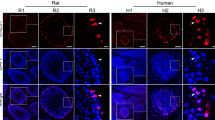Abstract
Basal activity and cellular localization of cAMP response element-binding protein (CREB) was examined in mouse testis during postnatal development and spermatogenesis. Testes of ICR mice sampled on postnatal day (PND) 3, 7, 14, 21, 28, 35, 42, and 49 were analyzed using Western blotting. Basal CREB activity was significantly higher in early phase (PND 3–7) develo** testes than in intermediate- and late-phase develo** (PND 14–42) and adult testes (PND 49). Furthermore, immunohistochemical analysis demonstrated the change of CREB phosphorylation in various testicular cell types during postnatal development. In particular, CREB phosphorylation in seminiferous tubules of the adult testis varied according to the spermatogenic cycle, while phosphorylation was evident in spermatogonia during all stages. Phosphorylation was moderate in pachytene spermatocytes of stages I–III and intense in round and elongate spermatids of spermiogenesis in stages XII–IX. These results suggest that CREB plays an important role in cell proliferation and differentiation in the early phase of postnatal development and spermatogenesis of mouse testis.



Similar content being viewed by others
References
Adham IM, Eck TJ, Mierau K, Müller N, Sallam MA, Paprotta I, Schubert S, Hoyer-Fender S, Engel W (2005) Reduction of spermatogenesis but not fertility in Creb3l4-deficient mice. Mol Cell Biol 25:7657–7664
Behr R, Weinbauer GF (1999) Germ cell-specific cyclic adenosine 3′, 5′-monophosphate response element modulator expression in rodent and primate testis is maintained despite gonadotropin deficiency. Endocrinology 140:2746–2754
Deutsch PJ, Hoeffler JP, Jameson JL, Lin JC, Habener JF (1988) Structural determinants for transcriptional activation by cAMP-responsive DNA elements. J Biol Chem 263:18466–18472
Don J, Stelzer G (2002) The expanding family of CREB/CREM transcription factors that are involved with spermatogenesis. Mol Cell Endocrinol 187:115–124
El-Alfy M, Azzi L, Lessard J, Lavergne É, Pelletier M, Labrie C (2006) Stage-specific expression of the Atce1/Tisp40α isoform of CREB3L4 in mouse spermatids. J Androl 27:686–694
Foulkes NS, Mellström B, Benusiglio E, Sassone-Corsi P (1992) Developmental switch of CREM function during spermatogenesis: from antagonist to activator. Nature 355:80–84
Hai T, Hartman MG (2001) The molecular biology and nomenclature of the activating transcription factor/cAMP responsive element binding family of transcription factors: activating transcription factor proteins and homeostasis. Gene 273:1–11
Iordanov M, Bender K, Ade T, Schmid W, Sachsenmaier C, Engel K, Gaestel M, Rahmsdorf HJ, Herrlich P (1997) CREB is activated by UVC through a p38/HOG-1-dependent protein kinase. EMBO J 16:1009–1022
Kim H, Moon C, Shin T (2008) Immunohistochemical study of flotillin-1 in the rat testis during postnatal development. Acta Histochem 110:224–231
Montminy M (1997) Transcriptional regulation by cyclic AMP. Annu Rev Biochem 66:807–822
Montminy MR, Bilezikjian LM (1987) Binding of a nuclear protein to the cyclic-AMP response element of the somatostatin gene. Nature 328:175–178
Muir T, Wilson-Rawls J, Stevens JD, Rawls A, Schweitzer R, Kang C, Skinner MK (2008) Integration of CREB and bHLH transcriptional signaling pathways through direct heterodimerization of the proteins: role in muscle and testis development. Mol Reprod Dev 75:1637–1652
Oakberg EF (1956) A description of spermiogenesis in the mouse and its use in analysis of the cycle of the seminiferous epithelium and germ cell renewal. Am J Anat 99:391–413
Persengiev SP, Green MR (2003) The role of ATF/CREB family members in cell growth, survival and apoptosis. Apoptosis 8:225–228
Tan Y, Rouse J, Zhang A, Cariati S, Cohen P, Comb MJ (1996) FGF and stress regulate CREB and ATF-1 via a pathway involving p38 MAP kinase and MAPKAP kinase-2. EMBO J 15:4629–4642
Thomas K, Sung DY, Yang J, Johnson K, Thompson W, Millette C, McCarrey J, Breitberg A, Gibbs R, Walker W (2005) Identification, characterization, and functional analysis of sp1 transcript variants expressed in germ cells during mouse spermatogenesis. Biol Reprod 72:898–907
Waeber G, Meyer TE, LeSieur M, Hermann HL, Gérard N, Habener JF (1991) Developmental stage-specific expression of cyclic adenosine 3′, 5′-monophosphate response element-binding protein CREB during spermatogenesis involves alternative exon splicing. Mol Endocrinol 5:1418–1430
Walker WH, Fucci L, Habener JF (1995) Expression of the gene encoding transcription factor cyclic adenosine 3′, 5′-monophosphate (cAMP) response element-binding protein (CREB): regulation by follicle-stimulating hormone-induced cAMP signaling in primary rat Sertoli cells. Endocrinology 136:3534–3545
Wang H, Chen Y, Ge Y, Ma P, Ma Q, Ma J, Wang H, Xue S, Han D (2005) Immunoexpression of Tyro 3 family receptors—Tyro 3, Axl, and Mer—and their ligand Gas6 in postnatal develo** mouse testis. J Histochem Cytochem 53:1355–1364
Weinbauer GF, Behr R, Bergmann M, Nieschlag E (1998) Testicular cAMP responsive element modulator (CREM) protein is expressed in round spermatids but is absent or reduced in men with round spermatid maturation arrest. Mol Hum Reprod 4:9–15
Yan C, Zhao AZ, Sonnenburg WK, Beavo JA (2001) Stage and cell-specific expression of calmodulin-dependent phosphodiesterases in mouse testis. Biol Reprod 64:1746–1754
Acknowledgments
This work was supported by the Grant of the Korean Ministry of Education, Science and Technology (The Regional Core Research Program/Biohousing Research Institute). This work was supported by the Biohousing Research Center.
Author information
Authors and Affiliations
Corresponding authors
Rights and permissions
About this article
Cite this article
Kim, JS., Song, MS., Seo, HS. et al. Immunohistochemical analysis of cAMP response element-binding protein in mouse testis during postnatal development and spermatogenesis. Histochem Cell Biol 131, 501–507 (2009). https://doi.org/10.1007/s00418-009-0554-8
Accepted:
Published:
Issue Date:
DOI: https://doi.org/10.1007/s00418-009-0554-8




